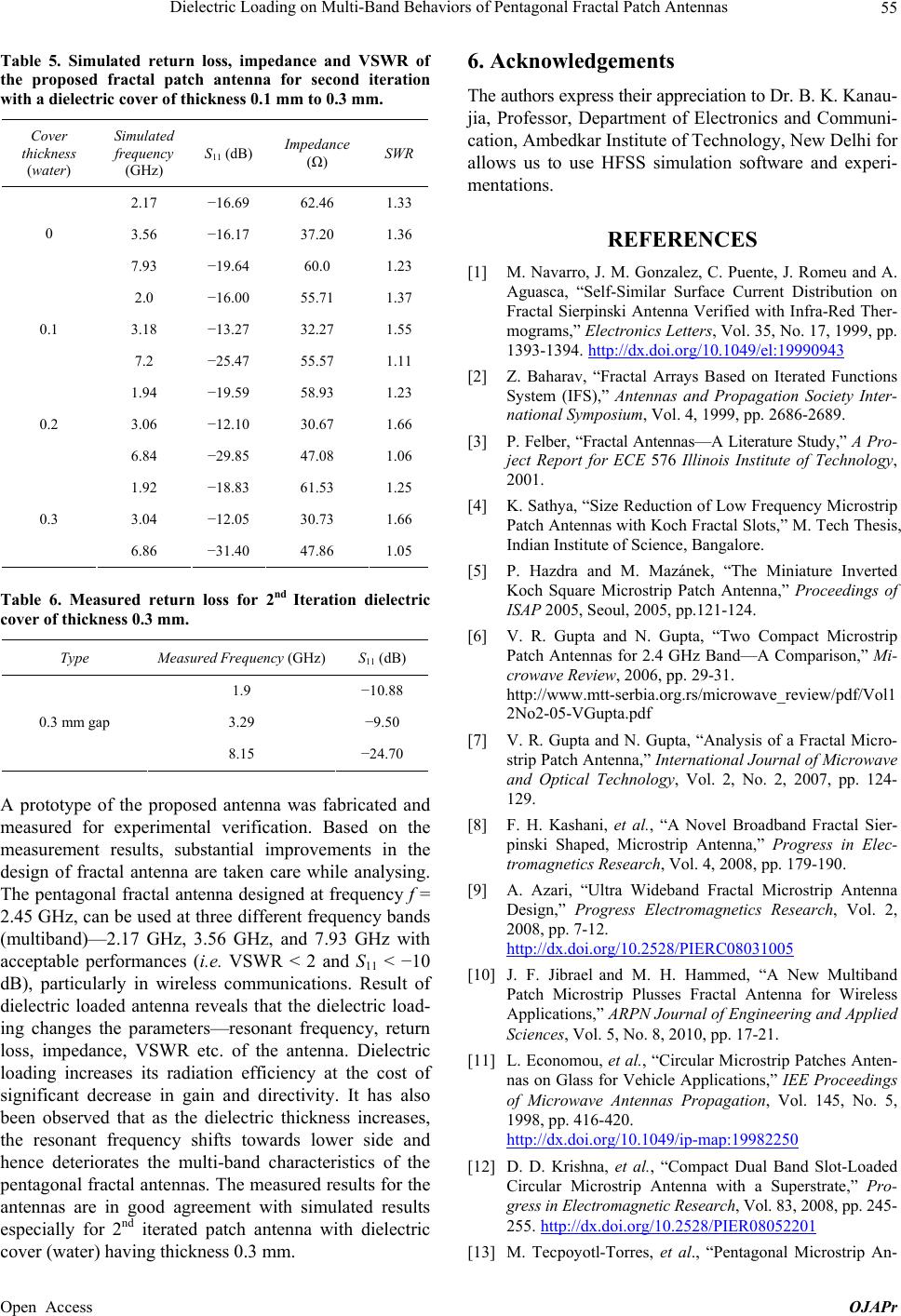
Dielectric Loading on Multi-Band Behaviors of Pentagonal Fractal Patch Antennas 55
Table 5. Simulated return loss, impedance and VSWR of
the proposed fractal patch antenna for second iteration
with a dielectric cover of thickness 0.1 mm to 0.3 mm.
Cover
thickness
(water)
Simulated
frequency
(GHz)
S11 (dB) Impedance
(Ω) SWR
2.17 −16.69 62.46 1.33
3.56 −16.17 37.20 1.36
0
7.93 −19.64 60.0 1.23
2.0 −16.00 55.71 1.37
3.18 −13.27 32.27 1.55
0.1
7.2 −25.47 55.57 1.11
1.94 −19.59 58.93 1.23
3.06 −12.10 30.67 1.66
0.2
6.84 −29.85 47.08 1.06
1.92 −18.83 61.53 1.25
3.04 −12.05 30.73 1.66
0.3
6.86 −31.40 47.86 1.05
Table 6. Measured return loss for 2nd Iteration dielectric
cover of thickness 0.3 mm.
Type Measured Frequency (GHz) S
11 (dB)
1.9 −10.88
3.29 −9.50
0.3 mm gap
8.15 −24.70
A prototype of the proposed antenna was fabricated and
measured for experimental verification. Based on the
measurement results, substantial improvements in the
design of fractal antenna are taken care while analysing.
The pentagonal fractal antenna designed at frequency f =
2.45 GHz, can be used at three different frequency bands
(multiband)—2.17 GHz, 3.56 GHz, and 7.93 GHz with
acceptable performances (i.e. VSWR < 2 and S11 < −10
dB), particularly in wireless communications. Result of
dielectric loaded antenna reveals that the dielectric load-
ing changes the parameters—resonant frequency, return
loss, impedance, VSWR etc. of the antenna. Dielectric
loading increases its radiation efficiency at the cost of
significant decrease in gain and directivity. It has also
been observed that as the dielectric thickness increases,
the resonant frequency shifts towards lower side and
hence deteriorates the multi-band characteristics of the
pentagonal fractal antennas. The measured results for the
antennas are in good agreement with simulated results
especially for 2nd iterated patch antenna with dielectric
cover (water) having thickness 0.3 mm.
6. Acknowledgements
The authors express their appreciation to Dr. B. K. Kanau-
jia, Professor, Department of Electronics and Communi-
cation, Ambedkar Institute of Technology, New Delhi for
allows us to use HFSS simulation software and experi-
mentations.
REFERENCES
[1] M. Navarro, J. M. Gonzalez, C. Puente, J. Romeu and A.
Aguasca, “Self-Similar Surface Current Distribution on
Fractal Sierpinski Antenna Verified with Infra-Red Ther-
mograms,” Electronics Letters, Vol. 35, No. 17, 1999, pp.
1393-1394. http://dx.doi.org/10.1049/el:19990943
[2] Z. Baharav, “Fractal Arrays Based on Iterated Functions
System (IFS),” Antennas and Propagation Society Inter-
national Symposium, Vol. 4, 1999, pp. 2686-2689.
[3] P. Felber, “Fractal Antennas—A Literature Study,” A Pro-
ject Report for ECE 576 Illinois Institute of Technology,
2001.
[4] K. Sathya, “Size Reduction of Low Frequency Microstrip
Patch Antennas with Koch Fractal Slots,” M. Tech Thesis,
Indian Institute of Science, Bangalore.
[5] P. Hazdra and M. Mazánek, “The Miniature Inverted
Koch Square Microstrip Patch Antenna,” Proceedings of
ISAP 2005, Seoul, 2005, pp.121-124.
[6] V. R. Gupta and N. Gupta, “Two Compact Microstrip
Patch Antennas for 2.4 GHz Band—A Comparison,” Mi-
crowave Review, 2006, pp. 29-31.
http://www.mtt-serbia.org.rs/microwave_review/pdf/Vol1
2No2-05-VGupta.pdf
[7] V. R. Gupta and N. Gupta, “Analysis of a Fractal Micro-
strip Patch Antenna,” International Journal of Microwave
and Optical Technology, Vol. 2, No. 2, 2007, pp. 124-
129.
[8] F. H. Kashani, et al., “A Novel Broadband Fractal Sier-
pinski Shaped, Microstrip Antenna,” Progress in Elec-
tromagnetics Research, Vol. 4, 2008, pp. 179-190.
[9] A. Azari, “Ultra Wideband Fractal Microstrip Antenna
Design,” Progress Electromagnetics Research, Vol. 2,
2008, pp. 7-12.
http://dx.doi.org/10.2528/PIERC08031005
[10] J. F. Jibrael and M. H. Hammed, “A New Multiband
Patch Microstrip Plusses Fractal Antenna for Wireless
Applications,” ARPN Journal of Engineering and Applied
Sciences, Vol. 5, No. 8, 2010, pp. 17-21.
[11] L. Economou, et al., “Circular Microstrip Patches Anten-
nas on Glass for Vehicle Applications,” IEE Proceedings
of Microwave Antennas Propagation, Vol. 145, No. 5,
1998, pp. 416-420.
http://dx.doi.org/10.1049/ip-map:19982250
[12] D. D. Krishna, et al., “Compact Dual Band Slot-Loaded
Circular Microstrip Antenna with a Superstrate,” Pro-
gress in Electromagnetic Research, Vol. 83, 2008, pp. 245-
255. http://dx.doi.org/10.2528/PIER08052201
[13] M. Tecpoyotl-Torres, et al., “Pentagonal Microstrip An-
Open Access OJAPr